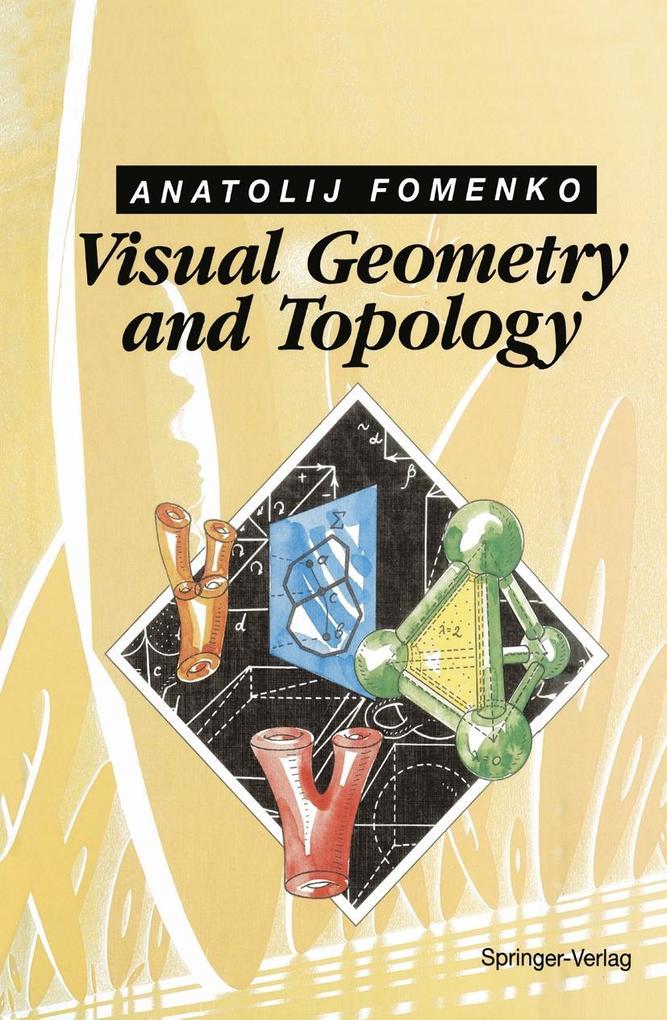
Sofort lieferbar (Download)
Geometry and topology are strongly motivated by the
visualization of ideal objects that have certain special
characteristics. A clear formulation of a specific property
or a logically consistent proof of a theorem often comes
only after the mathematician has correctly "seen" what is
going on. These pictures which are meant to serve as
signposts leading to mathematical understanding, frequently
also contain a beauty of their own.
The principal aim of this book is to narrate, in an
accessible and fairly visual language, about some classical
and modern achievements of geometry and topology in both
intrinsic mathematical problems and applications to
mathematical physics. The book starts from classical notions
of topology and ends with remarkable new results in
Hamiltonian geometry. Fomenko lays special emphasis upon
visual explanations of the problems and results and
downplays the abstract logical aspects of calculations. As
an example, readers can very quickly penetrate into the new
theory of topological descriptions of integrable Hamiltonian
differential equations. The book includes numerous graphical
sheets drawn by the author, which are presented in special
sections of "Visual material". These pictures illustrate the
mathematical ideas and results contained in the book. Using
these pictures, the reader can understand many modern
mathematical ideas and methods.
Although "Visual Geometry and Topology" is about
mathematics, Fomenko has written and illustrated this book
so that students and researchers from all the natural
sciences and also artists and art students will find
something of interest within its pages.
visualization of ideal objects that have certain special
characteristics. A clear formulation of a specific property
or a logically consistent proof of a theorem often comes
only after the mathematician has correctly "seen" what is
going on. These pictures which are meant to serve as
signposts leading to mathematical understanding, frequently
also contain a beauty of their own.
The principal aim of this book is to narrate, in an
accessible and fairly visual language, about some classical
and modern achievements of geometry and topology in both
intrinsic mathematical problems and applications to
mathematical physics. The book starts from classical notions
of topology and ends with remarkable new results in
Hamiltonian geometry. Fomenko lays special emphasis upon
visual explanations of the problems and results and
downplays the abstract logical aspects of calculations. As
an example, readers can very quickly penetrate into the new
theory of topological descriptions of integrable Hamiltonian
differential equations. The book includes numerous graphical
sheets drawn by the author, which are presented in special
sections of "Visual material". These pictures illustrate the
mathematical ideas and results contained in the book. Using
these pictures, the reader can understand many modern
mathematical ideas and methods.
Although "Visual Geometry and Topology" is about
mathematics, Fomenko has written and illustrated this book
so that students and researchers from all the natural
sciences and also artists and art students will find
something of interest within its pages.
Inhaltsverzeichnis
1 Polyhedra. Simplicial Complexes. Homologies. - 1. 1 Polyhedra. - 1. 2 Simplicial Homology Groups of Simplicial Complexes (Polyhedra). - 1. 3 General Properties of Simplicial Homology Groups. - 2 Low-Dimensional Manifolds. - 2. 1 Basic Concepts of Differential Geometry. - 2. 2 Visual Properties of One-Dimensional Manifolds. - 2. 3 Visual Properties of Two-Dimensional Manifolds. - 2. 4 Cohomology Groups and Differential Forms. - 2. 5 Visual Properties of Three-Dimensional Manifolds. - 3 Visual Symplectic Topology and Visual Hamiltonian Mechanics. - 3. 1 Some Concepts of Hamiltonian Geometry. - 3. 2 Qualitative Questions of Geometric Integration of Some Differential Equations. Classification of Typical Surgeries of Liouville Tori of Integrable Systems with Bott Integrals. - 3. 3 Three-Dimensional Manifolds and Visual Geometry of Isoenergy Surfaces of Integrable Systems. - 4 Visual Images in Some Other Fields of Geometry and Its Applications. - 4. 1 Visual Geometry of Soap Films. Minimal Surfaces. - 4. 2 Fractal Geometry and Homeomorphisms. - 4. 3 Visual Computer Geometry in the Number Theory. - Appendix 1 Visual Geometry of Some Natural and Nonholonomic Systems. - 1. 1 On Projection of Liouville Tori in Systems with Separation of Variables. - 1. 2 What Are Nonholonomic Constraints? . - 1. 3 The Variety of Manifolds in the Suslov Problem. - Appendix 2 Visual Hyperbolic Geometry. - 2. 1 Discrete Groups and Their Fundamental Region. - 2. 2 Discrete Groups Generated by Reflections in the Plane. - 2. 3 The Gram Matrix and the Coxeter Scheme. - 2. 4 Reflection-Generated Discrete Groups in Space. - 2. 5 A Model of the Lobachevskian Plane. - 2. 6 Convex Polygons on the Lobachevskian Plane. - 2. 7 Coxeter Polygons on the Lobachevskian Plane. - 2. 8 Coxeter Polyhedra in the Lobachevskian Space. - 2. 9 Discrete Groups of Motions of Lobachevskian Space and Groups of Integer-Valued Automorphisms of Hyperbolic Quadratic Forms. - 2. 10 Reflection-Generated Discrete Groups in High-Dimensional Lobachevskian Spaces. - References.
Produktdetails
Erscheinungsdatum
06. Dezember 2012
Sprache
englisch
Seitenanzahl
324
Dateigröße
40,07 MB
Autor/Autorin
Anatolij T. Fomenko
Übersetzung
M. V. Tsaplina
Verlag/Hersteller
Kopierschutz
mit Wasserzeichen versehen
Produktart
EBOOK
Dateiformat
PDF
ISBN
9783642762352
Entdecken Sie mehr
Bewertungen
0 Bewertungen
Es wurden noch keine Bewertungen abgegeben. Schreiben Sie die erste Bewertung zu "Visual Geometry and Topology" und helfen Sie damit anderen bei der Kaufentscheidung.









